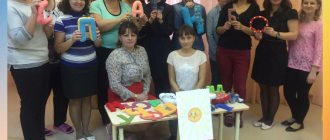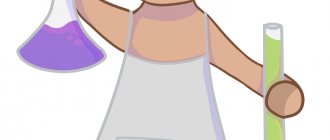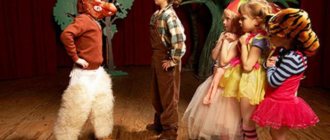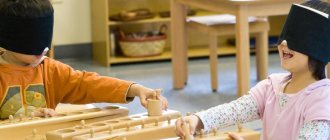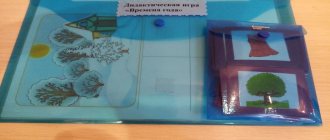The interaction of the speech therapist with the group teachers is a very important point, because teachers spend a lot of time with children and can help a child with speech disorders. They can include speech therapy exercises in games, monitor the purity of speech and correct sound pronunciation during a walk, in class, during a morning appointment, but they lack knowledge in this area.
Constant interaction between a speech therapist and teachers is necessary for the formation of correct speech skills in children with speech pathology and brings excellent results. In addition, joint work is also necessary because eliminating speech defects requires an integrated approach, since speech disorders are associated with a number of reasons, both biological and social. An integrated approach to overcoming speech impairment involves a combination of correctional pedagogical and therapeutic work, and this requires the interaction of a speech therapist and a teacher.
Tasks of joint work between a speech therapist and educators
- Together, find the best options for working with a specific group and with each child individually, agree on the organization, conduct of classes, and their content.
- Arrange classes so that the speech therapist does not duplicate the tasks that the teacher gives to the children, and vice versa.
- Teach children correct sound pronunciation, perception and reproduction of words. Teach them to maintain the correct pace and rhythm of speech (not to chatter, but also not to speak too slowly).
- Expand the vocabulary of preschoolers.
- Help children study the process of word formation and grammatical structure. It is recommended to correct grammatical errors in speech not only in class, but also during walks, games, etc.
- Develop higher mental functions: thinking, imagination, attention, memory. Form coherent speech among students.
- Develop fine and articulatory motor skills in children.
MAGAZINE Preschooler.RF
From the experience of work “Interaction of educators with a speech therapist teacher”Prepared by the teacher of the preparatory group for school: Olga Vitalievna Smirnova
I work as a teacher in a pre-school group, my work is based on close contact with the teacher - speech therapist.
At the beginning of the school year, a specialist acquaints teachers with the results of an examination of children’s speech. We fill out a table on children's sound pronunciation, which reflects the level of speech development and the state of speech sound culture. This table is included in the group's work program.
Throughout the year, we keep maps of each child’s individual development. “speech development” section together with the speech therapist. Based on development indicators, we draw up an individual route for each child, which includes work on speech development. Together with a specialist, we discuss a long-term plan and clarify the most rational methods of speech correction for each child.
We use the following methods and forms of work with children who have problems in speech development:
- daily articulation exercises;
- logochas (syllable exercises, inventing phrases, memorizing tongue twisters, poems, proverbs);
- individual lessons with children, which are aimed at automating already established sounds (pronouncing syllables, words, phrases, memorizing poems).
Articulatory gymnastics helps to develop clear and coordinated movements of the organs of the articulatory apparatus. The group has a card index of articulatory gymnastics, mirrors, pictures and diagrams.
Logo hour - includes reinforcing sounds, pronouncing tongue twisters, tongue twisters, syllable exercises, word games, breathing exercises to develop proper breathing, games to enrich the vocabulary, games to develop a sense of rhythm.
In the morning, while walking, during routine moments we use:
- games for the development of phonemic hearing and phonemic perception ( “Find the first and last sound” , “Clap or walk the word” , “Catch the sound” , “Parrot” , “Pick up the word” , “On the contrary” , “Say the words in pairs” );
- on the development of the lexical side of speech (enrichment and activation of children’s vocabulary) ( “Guess and name” , “Housewarming” , “I know five ...” , “The cat is the opposite” , “Say it differently” , “Family of words” );
- to develop and improve the sound culture of speech ( “Catch the word” , “Finish the phrase” , to automate the sound in speech we memorize phrases and poems);
- on the development of the grammatical side of speech - to exercise the ability to form different forms of the same word ( "Greedy" , "Dwarves and Giants" to coordinate different parts of speech in gender, number and case),
Interaction with a speech therapist makes it possible to:
- mutually attend directly organized educational activities with children,
- correctly plan educational activities to consolidate material in different types of children’s activities,
- jointly prepare children for all children's holidays, because The speech therapist, taking into account the children’s capabilities, selects and corrects speech material, determines the level of difficulty, gives recommendations to teachers, helps in memorizing poems and roles with children,
The work of a teacher and the work of a speech therapist are different. The main difference: a speech therapist corrects speech disorders, and we, under the guidance of a speech therapist, actively participate in the automation of sounds, the development of vocabulary and grammar, and coherent speech. During routine moments, we control the children’s pronunciation of already assigned sounds.
In our work, we use the principle of consistency and interconnection of educational material, its accessibility, which has a positive effect on the quality of speech development of children in our group.
To prevent dysgraphia in children with speech disorders, together with a speech therapist, we use finger games, graphic simulators, graphic dictations, games “Looking at the letters in the mirror” , noisy pictures “Letters mixed up” , shading letters, sculpting letters from plasticine, cutting out letters, graphic dictations .
In accordance with the lexical topics of the week, we select finger exercises with poetry. To make it more interesting, we include game objects (rubber band, pencil, ball) in finger games. We systematically organize productive activities using the Origami technique, which provides good training for the fingers, promotes the development of hand movements, and develops the accuracy of small finger movements. Origami is an activity that uses both hands at the same time.
Children enjoy traveling through the labyrinths. Maze games are fun and not only teach your child to focus on a task, but also develop gross motor skills (hand and forearm movements). When completing tasks, you need to make sure that the position of the hand changes, and not the sheet with tasks. For children who have noticeable fine motor skills impairments, I suggest collecting mosaics, puzzles, and construction sets. If the fingers develop, then thinking and speech will develop. Graphic dictations promote orientation in space, reinforce the concepts of top, bottom, right, left, and develop visual perception and auditory attention.
The speech therapist teacher helps us in our work: conducts directly organized educational activities for teaching literacy, selects literature, speech material, didactic games, articulation and finger gymnastics for us. I help by creating interactive games for differentiating sounds, composing complex sentences, learning the syllabic structure of words, and reinforcing sounds and letters.
The specialist conducts consultations, master classes, and workshops for teachers, in which he introduces speech games for children of different ages, literature on this topic, and improves our ability to correctly use methods and techniques for the development of children’s speech.
It is necessary to note another important area in the joint work of a speech therapist and a teacher - the relationship with parents. We provide consultations for parents, prepare moving folders, and prepare joint parent-teacher meetings. Each child attending a speech center has a notebook for individual work, which is led by a speech therapist and which both group teachers and parents have the opportunity to study.
We work with children throughout the day, having the opportunity to repeatedly repeat speech material, repeat and reinforce new words, without which their introduction into the child’s independent speech cannot occur. Thanks to the relationship between a speech therapist and a teacher, it is possible to more effectively correct speech defects and prepare the child for school.
| Next > |
What is the interaction between a speech therapist and educators?
- Carrying out work by educators prior to speech therapy classes to accumulate, expand, and activate the vocabulary, providing the necessary cognitive and motivational basis for the formation of speech skills.
- Conducting systematic exercises to develop breathing, articulation, fine and gross motor skills.
- When planning and conducting educational activities in mathematics, cognitive development, artistic and creative activities, integrate speech therapy goals.
- Creating conditions in the group that promote the activation of children’s speech.
- Systematically monitor children’s speech not only during educational activities, but also in special moments.
- Explain (if necessary) the tasks of the speech therapist to parents to consolidate the material covered during home activities, which include replenishment, clarification, activation of the dictionary, consolidation of correct sound pronunciation, development of fine and articulatory motor skills.
And in conclusion, I would like to say that it is the joint work of the speech therapist and educator that will give positive dynamics in the speech development of each preschool student.
Seminar-workshop: “Joint work of a speech therapist and a teacher at the stage of automation of sounds”
Seminar-workshop: “Joint work of a speech therapist and a teacher at the stage of automation of sounds.”
SEMINAR - WORKSHOP:
“The joint work of a speech therapist and a teacher at the stage of automation of sounds.”
During the diagnostic stage, each child undergoes an individual speech therapy examination, where the speech therapist gets an idea of the state of the child’s speech activity and draws up an individual plan for correctional work.
The correction stage includes the production of impaired sounds, their automation and differentiation. In parallel with this, problems related to the formation and development of phonemic perception and the lexico-grammatical structure of speech are solved. Classes are conducted both individually and in small subgroups of 2-3 children with structurally similar defects in sound pronunciation. After the sound is set, the stage of its automation in words, phrases, poems and texts begins. The duration of sound production and their automation may vary and depends on the complexity of the violation. At the end of the correctional stage, the child moves to the dynamic observation group, i.e., the assessment and control stage begins, during which the speech therapist and educators monitor the process of sound automation in spoken speech. Taking into account that children with SLI have insufficient development of all language structures, violations of general, fine, articulatory motor skills, and prosodic components of speech, I believe that the most effective correction of a speech defect is possible by using an integrated approach to overcoming it. For each lesson, I select exercises for the development of articulation and fine motor skills, self-massage, speech breathing, voice, pronunciation and teaching children to read and write.
The effectiveness of correctional work largely depends on interaction with teachers of those groups attended by children with speech disorders. Competent work with children who have deficiencies in speech development is of great, often decisive, importance in the effectiveness of the correction process. However, often due to various objective and subjective reasons (teachers lack a sufficient amount of correctional pedagogical knowledge, proper awareness and adequate assessment of their role in overcoming speech development deficiencies), it is quite difficult to organize it at the optimal level. In addition, it should be taken into account that educators work in all sections of the preschool education program and often experience difficulties in planning, organizing and conducting correctional classes with children. This is why coordination of the work of the speech therapist and educator is so important.
Thus, the need arose for close interaction and mutual assistance between the speech therapist and teachers of the age group whose children attend speech therapy classes. Due to the specifics of the work of general developmental preschool educational institutions, educators are deprived of specialized correctional hours for working with “difficult” children, and must find time in their work or include components of correctional assistance in the general educational process of their group. Therefore, I created a mobile set of materials on speech correction (“Mobile correction” - MK). It is based on: a series of books “Home Notebooks” on the correction of sound pronunciation (different authors), subject pictures for different sounds, a card index of exercises for self-massage, facial gymnastics, motor psychophysical gymnastics, a card index with complexes for the development of articulatory gymnastics, a card index with speech material for automation and differentiation of sounds, a card index of games with speech and movement, a card index of games for correcting lexical and grammatical categories, as well as toys for blowing and developing fine motor skills. Goal: to promote the development of articulatory motor skills and automation of sounds set by a speech therapist, also solving problems with the development of lexical and grammatical categories.
Recommendations for the use of MK materials correspond to the generally accepted algorithm for automating sounds: clear pronunciation of an isolated sound, then the sound in a syllable, words, in a sentence, in coherent speech. Speech therapist consultations for teachers are devoted to this topic. The speech therapist brings the material and assignment (specifically for each child as needed) to the group.
Educators can also include tasks in the calendar plan for individual work with children with speech disorders, thus providing correctional assistance to the speech therapist in the formation of different aspects of speech. The work of the teacher to help the speech therapist becomes focused, specific and effective. Based on the speech therapist’s assignments for individual work, the teacher can structure his classes taking into account the speech problems of each child. MK also contains various tasks to improve phonemic awareness.
The relationship notebook will help the teacher navigate what kind of correctional work to carry out with a particular child.
In the process of working on the sound culture of speech, each age group is assigned its own tasks.
Junior group
1. Prepare the articulatory apparatus for the correct pronunciation of all sounds of the native language, training its basic movements during articulatory gymnastics and in the process of working on sounds that are easy to pronounce.
2.Develop auditory attention, speech hearing. Speech breathing, voice strength and pitch.
3. Develop clear pronunciation of words and sentences, a calm pace and measured rhythm of speech.
Middle group
1. Prepare the articulatory apparatus for the correct pronunciation of all sounds of the native language, I train its basic movements during articulatory gymnastics.
2. Call out and consolidate or clarify the pronunciation of whistling sounds.
3.Develop phonemic hearing, speech breathing, strength and pitch of voice.
4.develop clear pronunciation of words and sentences, a calm pace and measured rhythm of speech.
Senior group
1. Train the clarity of movements of the organs of the articulatory apparatus in the process of articulatory gymnastics and while working on certain sounds.
2.Evoke and consolidate, and for some children only clarify the pronunciation of certain sounds.
3.Continue to work on developing phonemic hearing, speech breathing, strength and pitch of voice.
4.Continue to work on clear pronunciation of words, highlighting individual sounds in the voice, on a calm pace and measured rhythm of speech.
Preparatory group for school
1.Continue to work on a clear, clear pronunciation of all sounds in various combinations.
2.Develop sound analysis of words.
3.Develop the ability to differentiate sounds that are similar in sound or articulation.
Since gaming is a leading activity for preschool children, in order to implement the listed tasks, it is necessary to select games. Pictures can be used to carry out a large number of speech games and exercises (for example: “The fourth is extra”, “One is many”, “What is missing?”, “One, two, five”, “Determine the place of the sound in the word”, “Compose word diagram”, “Who lives in the house?”, “Come up with a riddle”, “Find it by description”).
Thanks to the work of the MK, a specially designated place appears in the group for individual and subgroup correctional classes of the teacher with children in the evening hours (on the instructions of the speech therapist), and the presented manuals save time in preparing and conducting such classes. This solves the problem of teachers’ reluctance to work with children in the evening.
Competent work with children who have deficiencies in speech development is of great, often decisive, importance in the effectiveness of the correction process.
I believe that important attention should be paid to preventive work in preschool educational institutions. The main goal of this work is to create by teachers a subject environment that would facilitate the fullest possible variety of material. There should also be a wide selection of aids and toys for the development of targeted air flow and for the development of fine motor skills. Preschool educational institutions have already accumulated experience in the use of finger gymnastics and various mobility games that combine speech and movement; many teachers use them as physical exercises in the classroom.
The ongoing joint work of educators and speech therapists has shown that close cooperation helps in quickly solving the problems of correcting speech disorders.
Get text
Consultation progress
- Introductory conversation.
One of the brightest trends in the modernization of education is the provision of state guarantees of accessibility and equal opportunities for children with disabilities to receive a full education. Thus, children with speech development disorders should receive timely and qualified correctional and speech therapy assistance in preschool settings. At the same time, the problem of finding effective ways to correct speech is becoming increasingly important.
Only with close cooperation and unity of the requirements of specialists is it possible to overcome the speech development disorders that children have. Collaboration between a speech therapist and preschool teachers plays a special role in the speech therapy group.
- Principles and features of organizing joint activities of a speech therapist teacher and a preschool educational institution logotype teacher.
The joint activities of a speech therapist and preschool educators are organized in accordance with the following goals:
- increasing the effectiveness of correctional and speech therapy work;
- rational distribution of speech therapist and educators’ activities during the day to avoid overloading children;
- adequate selection of forms, methods, techniques and means of correctional pedagogical activities of the speech therapist and educators, aimed at both the entire group of children and an individual child.
The main types of organization of joint activities of a speech therapist and educators:
- joint study of the content of preschool educational institutions programs and drawing up a joint work plan;
- open classes with a speech therapist teacher to familiarize educators with basic teaching techniques, the selection of visual and speech material, as well as the requirements for children’s speech;
- discussion of the results of joint work with children, which was carried out in and outside the classroom;
- joint preparation for children's parties;
- development of general recommendations for parents.
Functions of a speech therapist and educator in the development of speech components of preschool children and non-speech mental processes associated with speech
Table 1.
| Functions of a speech therapist | Functions of a teacher |
| Development of the phonetic component of the language system. | Improving speech breathing, articulation and fine manual motor skills of children. Constant control over the correct pronunciation of the given sounds. |
| Formation of phonemic processes. | Taking into account the lexical topic chosen by the speech therapist during all group classes during the week. |
| Improving the state of the lexical component of speech. | Incorporation of practiced grammatical structures into situations of natural communication in children. |
| Development of the word formation process of nouns, adjectives, verbs. | Formation of coherent speech. |
| Formation of the grammatical structure of speech. | Strengthening graphomotor skills. |
| Improving coherent speech. | Development of attention, memory, verbal-logical thinking, imagination in game exercises on defect-free speech material. |
| Improving graphomotor skills and introducing children to the basics of literacy. | |
| Development of non-speech mental functions closely related to speech: verbal-logical thinking, memory, attention, imagination. |
Educators carry out the tasks of the speech therapist every day, using individual, subgroup and frontal forms of work, as well as routine moments.
Educators should know:
- main directions of the correctional program;
- age-related and individual characteristics of speech formation in preschoolers;
- features of the pronunciation and lexico-grammatical aspects of speech and take into account the speech capabilities of each child in the process of educational and extracurricular activities.
Educators must comply with the conditions for the development of speech activity and verbal communication of children:
- organize and support children’s verbal communication in class and outside of class;
- encourage you to listen carefully to other children;
- develop skills of self-control and critical attitude to speech;
- organize games to develop the sound culture of speech;
- carry out work on the development of auditory and speech attention.
Speech therapy group teachers should not:
- rush the child to answer;
- interrupt speech and rudely pull it back, but should tactfully give an example of correct speech;
- force the child to pronounce a phrase rich in sounds he has not yet identified;
- let memorize texts and poems that the child cannot yet pronounce.
It is recommended to allocate a place in the group for speech therapy classes, the so-called speech therapy corner, in which there should be board-printed games for the formation of the correct air flow, the development of non-speech processes, in the joint activity of an adult with children, in the free independent activity of children.
The speech therapist, together with preschool teachers, designs the parent corner, prepares and conducts parent meetings.
- Conclusion.
Correct, pedagogically justified interaction between educators and a speech therapist, combining their efforts in the interests of speech correction in children, is based on the creation of a friendly, emotionally positive environment in a speech therapy group.
Speech development is decisive in the level of human intelligence and culture. Correct, literate speech shows whether children are ready for school and whether they can successfully master literacy and reading.
Properly planned lessons of the teacher and speech therapist ensure the correct consolidation of the material in various types of children’s activities. Such interaction creates a unified correctional and developmental environment around the child.
The psychological atmosphere in the children's team strengthens children's faith in their own capabilities, allows them to smooth out negative experiences associated with speech impairment, and develop interest in classes.
Properly organized psychological and pedagogical influence of educators in most cases prevents the appearance of persistent unwanted deviations in behavior and forms collective friendly, socially acceptable relationships in the speech therapy group.
Literature
- Ivanova O.F. Ways to optimize the joint work of a speech therapist and educator // Scientific and methodological journal Speech therapist, 2009, No. 3
- Karpova S.I., Mamaeva V.V., Nikitina A.V. Interaction in the work of speech group specialists // Speech therapist in kindergarten, 2007, No. 9 (24).
- Konovalenko V.V. Individual and subgroup work on correcting sound pronunciation. – M.: GNOM Publishing House, 2016. – 216 p.
- Morozova V.V. Interaction of a speech therapist with teachers of preschool educational organizations. – SPb.: PUBLISHING HOUSE “CHILDHOOD-PRESS” LLC, 2014. – 96 p.
- Smirnova L.N. The relationship in the work of a speech therapist and a teacher / Scientific and methodological journal Speech therapist, 2008, No. 2
